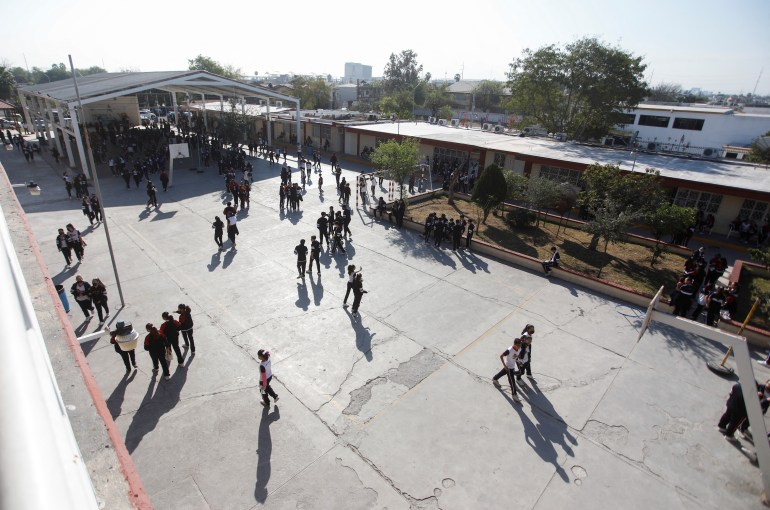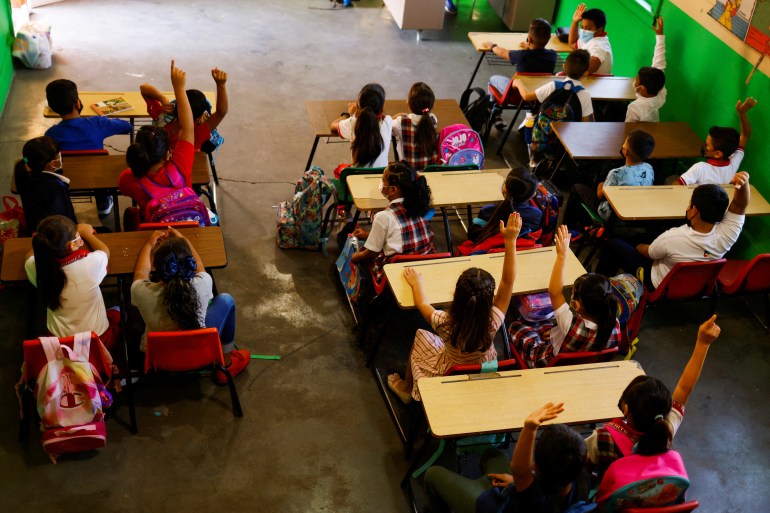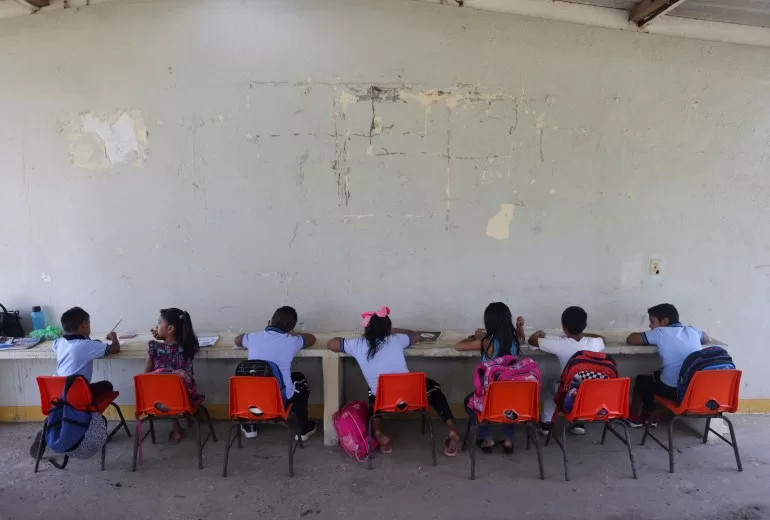But as Soto sees it, the problem lies not just in learning delays accumulated during months of remote education. It stems equally from an ongoing trend of classroom crime.
The Eduardo O’Gorman elementary school, in Guadalajara’s impoverished Chulavista neighbourhood, has been the victim of near-constant robberies since 2020, Soto said. The latest occurred this past October.
Bit by bit, furniture, electrical equipment and plumbing infrastructure — down to the toilets and sinks in the bathrooms — have disappeared from the campus, which features a pair of skeletal two-storey buildings linked by a square patch of asphalt, decorated with hopscotch squares.
The school has become a buffet for local criminals who resell stolen goods, at the expense of the community’s children. Many of the thefts occurred in broad daylight, with multiple witnesses and security camera footage as evidence. But police investigations have not yielded any answers or any change, Soto said.
“They stole everything little by little, the cables, the windows, the sinks,” she explained. “The neighbours had to have seen who was doing it, but no one admitted that they saw anything.”
What is happening at O’Gorman elementary is part of a nationwide trend. In the year after the COVID-19 pandemic began, the National Union of Educational Workers (SNTE), Mexico’s largest teachers’ union, estimated that 40 to 50 percent of the nation’s schools had faced robbery or vandalism.
Teachers and education advocates like Soto say that heightened risk has yet to subside. And they fear that the continued threat of theft will exacerbate the education setbacks wrought by the pandemic.
“We couldn’t return to school for two years, so we did online class, and now 35 percent of the kids can’t read,” Soto said.

Fernando Ruíz, an investigator at Mexicanos Primero, a non-profit involved in improving the Mexican public education system, told Al Jazeera that school robberies continued throughout 2023 at high levels, affecting 11,000 of the schools his organisation worked with last fall.
The damage can end up shuttering educational facilities indefinitely, he added. “There are schools that remain pretty much abandoned.”
Ruíz and other advocates suspect the number of schools affected is likely much higher. But the Mexican government has not collected data on the subject since 2022.
In a press conference in July 2023, Daniel Covarrubias Lopez, the SNTE’s secretary general, remarked on the frequency of school robberies by saying, “This is our daily bread.”
For Soto — a short teacher with tall, block heels whose firm, measured tone lays bare her decades of experience — the constant repairs and replacements required at her school have left classrooms with few resources.
Midway through the pandemic, the school was able to gather money from state government grants, allowing it to make the minimum necessary repairs.
“When we were able to raise money, the first thing we did was replace the electricity, so workmen could come do construction,” Soto said. “But the next day, the new cables were gone.”
Because the school could not afford further fixes, students continued online classes well after the risk of COVID-19 abated in the community. In-person classes only resumed in 2022, thanks to further government assistance and a private donation.
Nearly four years after the start of the ordeal, the school is still struggling to keep afloat. Some days, students are turned away at the school gate because the water tank has malfunctioned, rendering the bathrooms unusable. The school does not have the funds to repair the issue.
“We started just telling the kids to hold it in,” Soto said. Every time she leaves for a weekend or holiday break, Soto fears she will return to a school in tatters.
“One time [in April 2023], I opened the door to my classroom, and it had been completely vandalised as well,” Soto said. “On the wall there was a message addressed to me, and I realised the person who did it had likely been my former student.”

While drug lords like Joaquín “El Chapo” Guzmán and his four sons, Los Chapitos, have gained a kind of celebrity status in Mexico, the everyday reality of organised crime intersects more often with poverty than with riches and fame.
The most recent government statistics, from 2022, indicate that 43.5 percent of the Mexican population grapples with poverty. Slightly more than 7 percent — or 9.1 million people — face extreme poverty.
Those numbers were even higher during the pandemic. Extreme poverty touched nearly 11 million people in 2020 alone, as businesses shuttered and residents self-isolated to reduce infection.
In low-income urban areas, the economic drought that characterised the pandemic years lingers. Advocates like Ruíz say already-vulnerable public schools are paying the price.
“What we’ve seen is the formation of groups dedicated to stealing electrical wiring. They’ve found the weak spots,” Ruíz said. “The minute [the schools] replace something, they come and take it again.”
Ruíz explained that the schools best able to recover from theft are the rare examples of community cooperation: institutions where parents, teachers and local officials all pitch in.
But most schools struggle to keep parents engaged, much less local officials. Ruíz added that law enforcement likewise devotes little time to the schools’ protection and upkeep.
“Most schools make police reports just to receive government aid if it is available,” Ruíz said. The police “almost never actually follow up with the cases”.

Even some of the schools that face only one or two robberies are left in precarious financial situations. The José Revueltas secondary school in Tepic, Nayarit, is one such case.
Last May, a group of men breached the school’s brick walls on two separate occasions and made off with over 30 metres (98 feet) of electrical cables, as well as computers and several pieces of furniture.
Without electrical cables, there was no air conditioning, and Diana Marujo, a member of the school’s administration, said students were becoming sweaty and distracted.
The school was forced to spend 7,000 pesos (over $400), a quarter of the following year’s budget, to replace the stolen cables. To compensate, Marujo told Al Jazeera that the school asked parents to contribute several hundred pesos more than the customary annual fee, which is an optional, though encouraged, donation that parents give to the school for supplies.
School employees also used a colleague’s pick-up truck to buy school supplies in bulk, in order to save money.
“We stopped being able to afford liquid soap, so we put bags of soap powder in the bathrooms. We had to start telling kids to bring their own toilet paper,” Marujo said. “We’re in danger of exhausting our budget.”
However, Ruíz expressed cautious hope that robberies will soon return to pre-pandemic levels as the Mexican economy stabilises.
“Over the winter break, we saw far fewer robberies for the first time since the beginning of the pandemic, and all of them were electrical cables, which is a good sign,” he said.
In Soto’s classroom, meanwhile, the fourth-graders take 15 minutes to slowly pencil in letters on their worksheets before the next lesson begins.
“You might notice some of the kids are still sitting on broken chairs,” she said. Some of the bricks in the wall are missing cement on one or two sides, so odd beams of light break through into the room.
